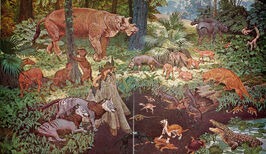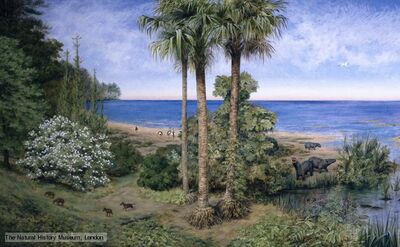
The Eocene began as a time of global warming, with temperatures across the planet soaring. Forests thrived and trees grew even in polar regions. Eventually, the Eocene became cooler and drier. As India continued to drift northwards, pushing against the Eurasian continent, the mass of rocks thrust up between them formed the Himalayas. At this time Africa was an island, not yet joined to the Middle East and Europe, but its own journey north was to trigger the formation of the Alps. Many species of grass evolved in the Eocene epoch, but were very limited in extent - today's grassy plains were still far in the future.

How the Eocene may have looked
Subdivisions[]
The Eocene epoch is usually broken into Early and Late, or - more usually - Early, Middle, and Late subdivisions. The corresponding rocks are referred to as Lower, Middle, and Upper Eocene. The Faunal stages from youngest to oldest are:
| Priabonian | (37.2±0.1 – 33.9±0.1 Ma) |
| Bartonian | (40.4±0.2 – 37.2±0.1 Ma) |
| Lutetian | (48.6±0.2 – 40.4±0.2 Ma) |
| Ypresian | (55.8±0.2 – 48.6±0.2 Ma) |
The Ypresian and occasionally the Lutetian constitute the Early, the Priabonian and sometimes the Bartonian the Late state; alternatively, the Lutetian and Bartonian are united as the Middle Eocene.
Paleogeography[]
During the Eocene, the continents continued to drift toward their present positions.
At the beginning of the period, Australia and Antarctica remained connected, and warm equatorial currents mixed with colder Antarctic waters, distributing the heat around the planet and keeping global temperatures high. But when Australia split from the southern continent around 45 Ma, the warm equatorial currents were deflected away from Antarctica, and an isolated cold water channel developed between the two continents. The Antarctic region cooled down, and the ocean surrounding Antarctica began to freeze, sending cold water and icefloes north, reinforcing the cooling.
The northern supercontinent of Laurasia began to break up, as Europe, Greenland and North America drifted apart.In western North America, mountain building started in the Eocene, and huge lakes formed in the high flat basins among uplifts, resulting in the deposition of the Green River Formation lagerstätte.In Europe, the Tethys Sea finally vanished, while the uplift of the Alps isolated its final remnant, the Mediterranean, and created another shallow sea with island archipelagos to the north. Though the North Atlantic was opening, a land connection appears to have remained between North America and Europe since the faunas of the two regions are very similar.
India continued its journey away from Africa and began its collision with Asia, folding the Himalayas into existence.It is hypothesized that the Eocene hothouse world was caused by runaway global warming from released methane clathrates deep in the oceans. The clathrates were buried beneath mud that was disturbed as the oceans warmed. Methane (CH4) has ten to twenty times the greenhouse gas effect of carbon dioxide (CO2).
Climate[]
Earth's surface temperatures generally rose from the late Palaeocene through the Early Eocene (~59 - 50 Ma), reaching maximum Cenozoic temperatures during the Early Eocene Climatic Optimum (EECO). Superimposed on this warming were a series of "hyperthermals". These are best described as geologically brief (<200 kyr) events characterized by rapid (in geological terms; it was far slower than either the warming predicted for the coming century or even the warming associated with the end of the last ice age) global warming and massive carbon input to the ocean and atmosphere. The most prominent of these events was the Palaeocene-Eocene Thermal Maximum or Initial Eocene Thermal Maximum (PETM or IETM), which began at the Palaeocene-Eocene Boundary. During this episode. Earth surface temperatures rose by 5-7 °C. The PETM coincided with a major mammalian turnover on land (that distinguishes Eocene fauna from Palaeocene fauna), and an extinction of many benthic foraminifera species in the deep sea. Less extreme but nonetheless pronounced hyperthermals followed the PETM, including Eocene Thermal Maximum 2 at ca. 53.7 Ma. Another hot interval occurred ~40 Ma, during the Middle Eocene Climatic Optimum (MECO) when deep sea temperatures rose about 4 °C. Coincident with MECO was a peak in atmospheric carbon dioxide levels and the formation of the Himalayas. The Eocene global climate was perhaps the most homogeneous of the Cenozoic; the temperature gradient from equator to pole was only half that of today's, and deep ocean currents were exceptionally warm. The polar regions were much warmer than today, perhaps as mild as the modern-day Pacific Northwest; temperate forests extended right to the poles, while rainy tropical climates extended as far north as 45°. The difference was greatest in the temperate latitudes; the climate in the tropics however, was probably similar to today's. The recent discovery of a giant snake (estimated length 13 m) in Colombia that may have lived during the Eocene suggests, on the contrary, that the tropics were much warmer than today, a conclusion in accord with numerical simulations of the climate during the Eocene.
Although the global climate remained comparatively warm throughout the rest of the Eocene it was this epoch that marked the start of a slow global cooling trend, possibly triggered by the Arctic Ocean Azolla event and the formation of the Antarctic circumpolar current following the final break up of Gondwana. This trend would eventually lead to the Pleistocene glaciations.